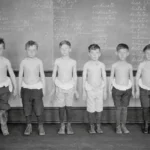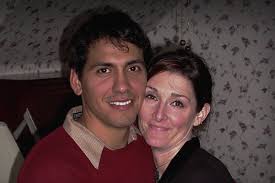
Baltimore, May 24, 2006. A hotel bellhop stopped just short of unlocking the door to the unused conference room. The smell was unmistakable. The Belvedere, once a symbol of old-city grandeur, had lived long enough to see its upper wings forgotten. The south wing’s second-floor meeting room had no reason to be visited—until now.
A hole had been spotted from above. Three colleagues from Stansberry & Associates had gone looking, peering from the parking structure next door. One of them noticed the dent first. It was irregular, about the size of a man. It looked like it had come from above.
The smell coming from the locked door matched what they feared. Baltimore police arrived and forced their way in. Inside, beneath that torn ceiling panel, lay the body of 32-year-old Rey Rivera. He had been missing for eight days.
There was no blood. Not the kind that usually coats a crime scene. The body had been there too long, decomposing beneath a hole in the roof that let in light, heat, and rain. The floor was silent and unused, the dust undisturbed except where the impact had ruptured the tiles. The distance between the hole and the body was not precise, but his limbs lay splayed from the impact, not dragged or posed. It had the look of something sudden.
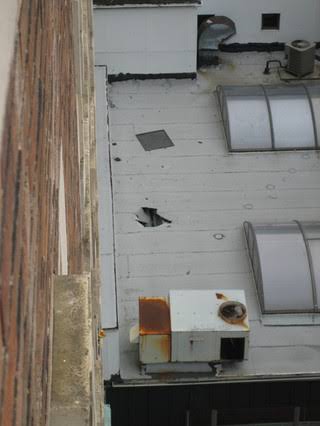
Rivera was tall—six foot five—and built like someone used to motion. A water polo player, an aspiring filmmaker, a man who had left California to build a life in Baltimore with his wife, Allison. They had been married for less than two years. He had recently finished a screenplay and had started a production company. There was talk of moving back to Los Angeles.
Now, his body was broken in ways the autopsy could not fully explain.
The coroner marked the cause of death as undetermined. The police said probable suicide. The evidence told neither story cleanly.
From the top of the Belvedere to the point of impact was approximately 177 feet. The building itself rose 188 feet. The physics were not kind. For someone to hit that specific lower roof, they would have had to run—or be flung—across a horizontal span of at least 43 feet. In flip flops.
The building’s rooftop was lined with a decorative mansard slope and wide, protruding cornices. Any trajectory from the top would have required clearance over these obstacles, followed by a sharp outward arc. The running space available was just over fifteen feet. Even sprinting, a man of Rivera’s height and weight could only achieve a burst of about ten miles per hour. That was not enough to explain the gap.
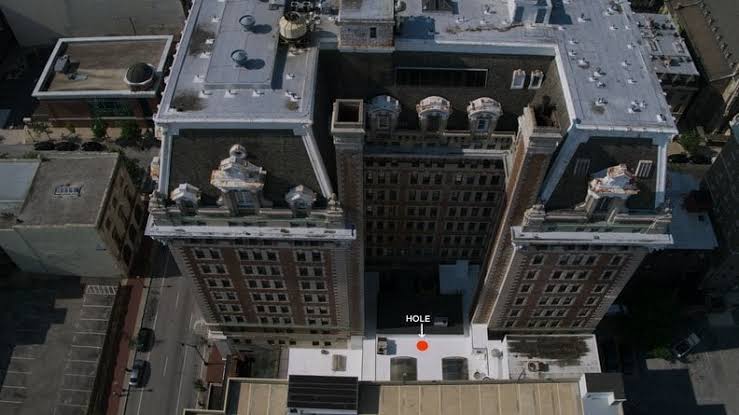
But it was not just the physics. Rivera’s glasses and cell phone were found near the hole, almost perfectly intact. No cracks, no scratches, no sign of the kind of blunt trauma that normally accompanies a fall from that height. His money clip—always in his pocket—was missing.
And yet the most curious detail was what investigators did not find.
The homicide file had no scene photos. No diagram of the room. No notes on body position. No mapping of trajectory. No interview transcripts. The police had not subpoenaed Rivera’s phone records. There were no statements from the colleagues who discovered the hole, nor from the hotel staff who were working that week. Not even from the house guest who heard him take the call that sent him rushing out the door on May 16.
There was no diagram showing where his body landed in the room. Not even a rough sketch. For an investigative team that ruled his death a suicide, this omission was not only careless. It was structural.
At the time, homicide detective units across the country had standardized the early stages of suspicious death scenes: record the precise point of impact, collect items near the body, take initial statements, and document who found the body and how. None of this was done.
Rey had been missing eight days when they found him. The decomposition made certain forensic readings unreliable. Blood had settled. Lividity patterns were harder to trace. But position, clothing, and nearby debris still told a story. A story no one had taken down.
Inside their Baltimore home, Allison Rivera found a note.
It was printed in extremely small font, taped behind Rey’s computer. Not the kind of place someone tapes a suicide note. The note was eight pages long, containing a mix of movie titles, Freemason quotes, codes, and names—some famous, some obscure. The tone was rapid, flighty, digressive. Some phrases seemed purposeful. Others felt like disjointed lines from scripts that had never been written.
The FBI analyzed the note. It did not meet the criteria of a suicide note. But it did raise a different question. Who was Rey Rivera, in those last days?
His wife remembered changes. She told investigators he had become jumpy, unusually protective. One day at a track, he had seen a man in the bleachers and become agitated, convinced the stranger meant harm. There were no physical threats that she could remember. But the anxiety had not passed.
Friends later said Rey had recently written something for Stansberry & Associates that upset the company. One of his last projects had involved promotional content for the investment firm’s more aggressive pitches. But there was no documented dispute. What was known: Rey received a phone call routed through the Agora switchboard—the parent company of Stansberry & Associates. The call came at 6:30 PM on May 16. He took it, paused, and then rushed out the front door. He never came back.
The hotel staff said the rooftop doors were locked. But the hotel, nearly a century old by then, had long been a patchwork of public and private tenants. Offices, condos, and event spaces all shared the same infrastructure. The south wing conference room was little-used. The roof access was supposed to be restricted. But urban explorers and contractors familiar with the Belvedere knew that not every lock in the building had teeth.
Security footage had already been taped over. The cameras pointed at the roof and upper hallways had not been working. The hotel claimed footage was overwritten weekly. Whether that was true in practice is unclear. It is not known when the rooftop camera stopped functioning, only that it offered nothing.
Some argued this meant cover-up. Others pointed to the hotel’s age and maintenance schedule. In 2006, cloud storage was rare and security systems still relied heavily on VHS rotation. If the footage was gone, it may not have been erased. It may have simply expired.
Among the few outside experts to weigh in was Marie Dauenheimer, a board-certified medical illustrator with decades of experience reconstructing injury patterns. Working from the autopsy report, she noted something curious: the injuries did not resemble those from a vertical fall.
The tibia and fibula on his right leg were shattered, but the left side showed almost no damage. The pelvis, too, was fractured asymmetrically. Facial fractures were extensive, but arm and hand injuries—usually present in defensive or instinctual bracing—were largely absent. Dauenheimer said she had drawn hundreds of injury charts for cases involving falls, scaffolding collapses, vehicle impacts. The pattern in Rivera’s body was not typical of a feet-first or flat fall. In fact, it resembled the kind of asymmetrical trauma seen in vehicular collisions, where the body is struck from one side.
The lack of bilateral injuries made her doubt the fall narrative.
That was one voice. The police did not consult her. Nor did they commission independent diagrams or reconstructions. The hole remained the only certainty. And the note, the only clue to his state of mind.
That note remains difficult to classify. Even psychologists disagree on its interpretation. Some see in it the marks of a manic episode: associative leaps, coded language, intense fixation. Others argue it reads more like a collage—a scriptwriter’s notes meant for some project never finished. There is no direct reference to death. But there is urgency.
The placement behind the computer, taped like a secret, suggests something deeply personal. Not necessarily a farewell. But maybe a manifesto. Or a shield.
We do not know what Rey thought the day he ran out the door.
Only that it started with a call.
And ended with a hole in the roof.
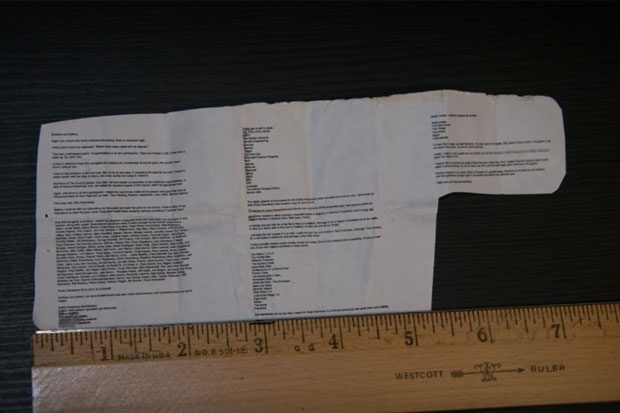
For eight days, no one looked up. Rey’s car had been found days earlier, parked just off St. Paul Street in a quiet lot behind the Belvedere. A black SUV, locked, untouched, filled with nothing of interest. Police chalked it up to a cold trail. It wasn’t.
Across the alley, the south wing of the hotel sat quiet. From street level, no one could see the hole in the roof. You had to be on the adjacent parking structure, at least three floors up, to get the right angle.
It was a former colleague who spotted it—one of three employees from Stansberry & Associates who went out to look. They had worked with Rey. Some said they had even been friends. But none of their statements appear in the case file. It is not clear if police ever asked for them.
The hole itself was unusual. The tiles around it were broken inward. As if something—someone—had come down fast. But the roof beneath the conference room showed no other signs of disturbance. No scuff marks. No drag trails. Just one deep impact zone, silent and still.
Police did not tape off the area. The forensic team took a few samples. There was no diagram. No documented reconstruction. The only conclusion was visual: if the hole was above the body, then the fall must have caused the death.
No effort was made to determine how—or from where—he had fallen.
The Belvedere’s architecture makes spontaneous jumps difficult. Built in 1903, the rooftop is wrapped with a deep cornice that extends outward, shielding most of the ledge. To leap from the top and reach the lower south wing, a person would need a running start, a high arc, and momentum. Rey’s flip-flops were not found near the hole. Some believe he was barefoot.
A 6’5 man would have needed to launch himself with speed to clear the cornice and travel 43 feet outward. Physics experts who later analyzed the case estimated a horizontal velocity of nearly 10 mph was required—nearly a sprint. The rooftop offers only 15 feet of running space.
And yet, there were no security cameras to confirm any movement on the roof.
It wasn’t the first time Allison Rivera had worried something was off.
Weeks before Rey’s disappearance, she said he had grown nervous. He flinched at odd noises. He checked the locks twice before bed. One day she went for a run at a nearby track. When Rey joined her, he stopped cold, staring at a man in the stands. He said the man had been watching her. She hadn’t noticed anything.
He had begun to sleep less. He was writing, but also pacing. He would stop midsentence and stare at nothing. Allison thought it was stress. He had left Los Angeles, moved to a new city, and had started freelancing for Stansberry’s company—an environment thick with sales pressure and late-night deadlines.
Rey was a writer by trade. Friends said he was imaginative. Playful, even. But lately, that creativity had turned rigid. He carried tension in his jaw. He became protective. If the phone rang at odd hours, he would answer it with sharp urgency, even if the number was blocked.
On May 16, the phone rang around 6:30 PM. Allison was away on a trip. A houseguest—a visiting colleague—was home. He said Rey answered the phone, paused, then rushed out. He left behind his wallet, a check he needed to deposit, and the day’s to-do list. He took only his phone, car keys, and a credit card.
He did not return that night. Or the next.
The day after he vanished, Stansberry’s company offered a $1,000 reward for information. The next day, they upped it to $5,000. Porter Stansberry himself retained a lawyer almost immediately and refused to speak to police. At the time, Stansberry & Associates was still under regulatory scrutiny for an SEC case from 2003. Publicity could not have helped.
Some colleagues cooperated. Others did not.
There were whispers of internal pressure—of a project Rey had worked on that had not gone over well. But the company denied any conflict. In their official statement, they expressed condolences and said they were “deeply saddened” by his death.
No one from the firm was officially questioned under oath. There are no transcripts. No subpoenas. Only the lingering detail that the phone call which sent Rey running out the door had come through the Agora Publishing switchboard.
A week later, the stench in the conference room was finally too strong to ignore.
Hotel management unlocked the door. The body had already begun to collapse in on itself. Time had erased some of its own evidence. The autopsy later estimated that Rey had died within 24 hours of going missing. That meant his body had been lying in that room while dozens of hotel guests slept a floor away.
There was no blood trail. The glass from the hole was scattered around, but none embedded in the body. His phone and glasses were found a short distance from the hole—intact. Both items should have shattered.
And yet, police released no statement detailing how those items were found, or why they had survived.
When Allison went through his things days later, she found the note.
Folded and taped behind the computer, in tiny font, typed neatly. It included film references, cryptic lists, strange dedications. Among them: names of actors, phrases from Freemason rituals, movie titles that seemed out of context. Nowhere did it say goodbye.
The FBI ruled the note not suicidal in nature. But psychiatrists later suggested that the structure of the note—its intensity, its breadth, its coded fixation—was not the work of someone thinking clearly. Some compared it to a flight of ideas, a symptom of mania.
The size of the font, the secretive taping, the sheer amount of material—it suggested someone in distress. Whether delusional, paranoid, or overwhelmed, it pointed to an altered state of mind.
Allison disagreed. She said Rey was creative. That he often brainstormed like that, building concepts out of associative leaps. To her, the note was strange, but not alarming.
Still, its presence was difficult to ignore. It was dated the day he disappeared.
Back at the Belvedere, the physical evidence was already starting to vanish.
Rain had come through the broken ceiling. The conference room had been locked, but it was not sealed. Maintenance workers had been in and out of adjacent areas. The perimeter had never been cordoned off.
There were reports—though never confirmed—of hotel staff remembering the sound of a crash on the night of May 16. But no one had called the police. No incident reports were filed. If any camera in the building caught the moment, it was already recorded over by the time investigators looked.
There was no search for fingerprints on the roof door. No ladder found nearby. No indication that anyone had been on the roof, or near it.
The conference room was quietly cleaned weeks later. The broken ceiling patched. The furniture returned. The hotel did not close off the floor.
The story began to settle.
A man received a call. He ran out the door. His body was found under a hole. He had been troubled.
Case closed.
Marie Dauenheimer had been watching the Netflix episode when she paused the screen. The autopsy report was on display for a few seconds, the text small, scrolling. She took a screenshot and began reading. Something didn’t sit right.
Dauenheimer is a board-certified medical illustrator. For over twenty-five years, she has drawn injury patterns for personal injury and wrongful death cases—building detailed maps of what a body goes through when struck, broken, or thrown.
She emailed the podcast team at The Land of the Unsolved, offering to illustrate Rey Rivera’s injuries for free. Not out of fascination, she said. But because the injuries did not make sense.
Rivera’s right tibia and fibula had both suffered compound fractures. His pelvis was shattered—but only on the right side. The skull and upper cervical spine showed severe trauma, and the ribs had caved inward. But the left leg was almost untouched. His arms showed no signs of defensive injury. The hands had bruises, but not the kind consistent with a brace-for-impact fall.
Most troubling of all: there was no uniform pattern to the damage. Not the kind seen in people who fall vertically from great heights. In scaffold or bridge collapses, Dauenheimer had seen bilateral injuries—both legs crushed, pelvis flattened, wrists shattered from instinctive reflexes. Rivera’s body did not follow that blueprint.
She noted the concentration of damage on the right side. The angle of injury, the nature of the fractures—these, she said, looked more like trauma from a side-strike. As if he had been hit by something heavy. A car, possibly. A blunt force moving object.
Not the ground.
She wasn’t alone in thinking so. Dr. Francisco J. Moya, a biomechanics expert who reviewed the injuries, found that the patterns were consistent with horizontal impact at speed. The single-sided pelvic damage, the lack of lower limb symmetry, the position of the head injuries—all suggested that Rivera may have been moving through the air, or struck in motion, not dropped from above.
Dauenheimer also highlighted what wasn’t visible: no fractures in the hands or forearms, no signs that Rivera had tried to break his fall.
Even if he had been unconscious, even if the fall was intentional, his body would have instinctively reached out. The absence of those injuries raised questions. Had he fallen? Or had he been placed?
Her conclusion was not absolute. She had no photographs, no X-rays, only the written report. But what she read made her doubt the ruling of suicide. Not because it was impossible. But because it had never been tested.
The police closed the case quickly. No follow-up interviews were conducted. No review of security footage from surrounding buildings. No efforts to trace the final phone call. There was no subpoena issued for Agora’s internal phone logs. Nor was there any forensic analysis of the rooftop.
When the autopsy was completed, the medical examiner listed the manner of death as undetermined. Not because the injuries were inconsistent with a fall, but because there was no clear evidence to rule otherwise.
That single word gave investigators an option. They labeled it a probable suicide and left it at that.
To the public, the case remained cold. But on forums, message boards, and inside the inboxes of journalists, interest grew.
Why would a man known for discipline and athleticism, who had just launched a film company and completed a screenplay, choose such a strange method of suicide?
Why was the note he wrote more cryptic than conclusive?
Why had he run out the door in a rush—taking only his phone and credit card—never to return?
And why had no one in the hotel seen or heard a 6’5 man reach a locked rooftop, leap across a cornice, and plunge through a roof without a trace?
Some began to suggest he never reached the roof at all.
The hole was real. But what if it was a ruse? If someone had wanted to conceal a murder, creating a plausible fall path would have been useful. Especially if the scene could mimic a jump. A single hole in an unused conference room, below a visible ledge, was enough.
In this theory, Rivera was struck elsewhere—possibly in the parking garage, where an eyewitness had told police there might be usable footage. That footage was never retrieved. The person who made that statement was never interviewed. The case file lists no attempt to recover parking garage surveillance from May 16, 2006.
Even among skeptics, suicide remained a possibility.
Some argued that Rivera may have been suffering from a psychotic break. The note, the erratic behavior, the sudden fear for his wife’s safety—all pointed to mental decline. He may have believed he could fly, or escape some unseen force. Delusions of that nature have led others to fatal leaps, often with no warning.
Still, the physics of the jump, the rooftop access, and the distribution of injuries made that theory incomplete.
And then there was the company.
Porter Stansberry never gave a statement. His lawyer deflected inquiries. The firm maintained that there was no conflict, no pressure, no incident. But several staff at Agora had noticed Rivera becoming more tense in the days before he disappeared. Some said he had written something he regretted. Others said he was growing paranoid.
The firm never released records of his work. No employee from the company has ever spoken on the record about his final project.
The last public attempt to reopen the case came after Unsolved Mysteries aired in 2020. The Baltimore Police Department said they would not reinvestigate without new evidence. None was offered. None was collected.
The Belvedere still stands. The conference room has been refurbished. The hole no longer exists.
Rey Rivera’s name is remembered mostly through questions.
What did he see that day?
What did he think was happening?
And why did the people who knew him best—his employers, his friends, his investigators—never ask harder?
By the time Allison Rivera read the autopsy in full, she already knew the words. Friends had warned her it was graphic. She said she braced herself. What she didn’t expect was how little it explained.
No diagram. No photos. No context for the trauma. The language was clinical but disjointed. It listed the injuries with precision—compound fractures, skull depression, rib collapse—but offered no theory of motion, no analysis of impact.
In Allison’s words, it “felt like a list of parts, not a human body.”
What made the case unravel wasn’t what happened, but how little was known afterward.
No one knows who placed the final call to Rey’s phone. The number was routed through Agora’s internal switchboard. By the time police attempted to trace it, the data was gone.
No one knows whether the rooftop door was locked that night. Hotel staff said it was usually secured. But that wing of the Belvedere was part of a multi-tenant patchwork: offices, condos, event spaces. Contractors had entered that roof dozens of times over the years. The building’s own maintenance logs, if they exist, were never entered into evidence.
No one knows what the three Stansberry employees—who spotted the hole—were doing on the garage roof that day. Their names appear nowhere in the case file. Their statements, if taken, were not kept. And the timing of their discovery has never been confirmed independently.
No one knows what was on the Belvedere’s rooftop security footage. The camera was broken, according to hotel staff. They could not say when it stopped working. All other footage had been erased automatically.
No one knows if Rey Rivera jumped, fell, or was thrown. The trajectory, according to independent physicists, would have required a full sprint and a precise leap. In flip-flops. Over a cornice. Across 43 feet.
No one knows why his cell phone and glasses remained intact, just feet from the impact zone.
No one knows what happened to the money clip he carried every day.
Some believe the answer lies in his state of mind.
Rey had been afraid. He was worrying more. Pacing. Jumping at shadows. The note, full of obscure references and secret codes, was seen by some as a document of a deteriorating mind. Others saw creativity. He had been writing screenplays. He was fascinated by mystery. But his wife admits: something had changed.
Others think the answer lies in what he knew. Something about Stansberry. Something he had written. Something he had said.
The truth is, no one knows that either.
Because no one ever asked.
The most striking detail of all may be this: the homicide file contains no crime scene photographs. Not of the room. Not of the body. Not of the hole.
There was no documented angle of the fall, no sketch of the landing point, no survey of the damage radius.
A conference room in an old hotel, full of quiet decay, became a tomb. Not because it held a secret. But because no one went back to look.
A few months after the case went cold, the conference room was repainted. Carpets were replaced. The hole was sealed.
The Belvedere returned to its usual rhythm. Events. Check-ins. Private parties. Its staff changed over. Maintenance logs aged out of memory. The cameras were repaired. The roof was locked again.
Only the questions remained.
In 2020, the Unsolved Mysteries reboot brought the case back into public view. Hundreds of tips came in. None were actionable. The Baltimore Police made no move to reopen the file. The medical examiner did not amend the cause of death. Rey Rivera remained “undetermined.”
But in the years since, people have done what police did not: They asked questions.
They walked the rooftop. Measured the distances. Timed the run. Read the autopsy. Interviewed the illustrator. Watched old episodes, paused the frames, and plotted injury maps. Some tracked down former employees. Some went looking for that final phone call.
A few kept records. Most just kept watching.
Not because they knew him.
But because they knew what it meant for someone to vanish in daylight.
If it was suicide, it was a man who broke quietly. A mind splintered by fear, reaching for symbols. A run across a rooftop. A leap no one saw.
If it was not, then someone moved a body. Built a story around a hole. Counted on silence.
Either way, the mystery did not begin at the roofline.
It began with the call.





